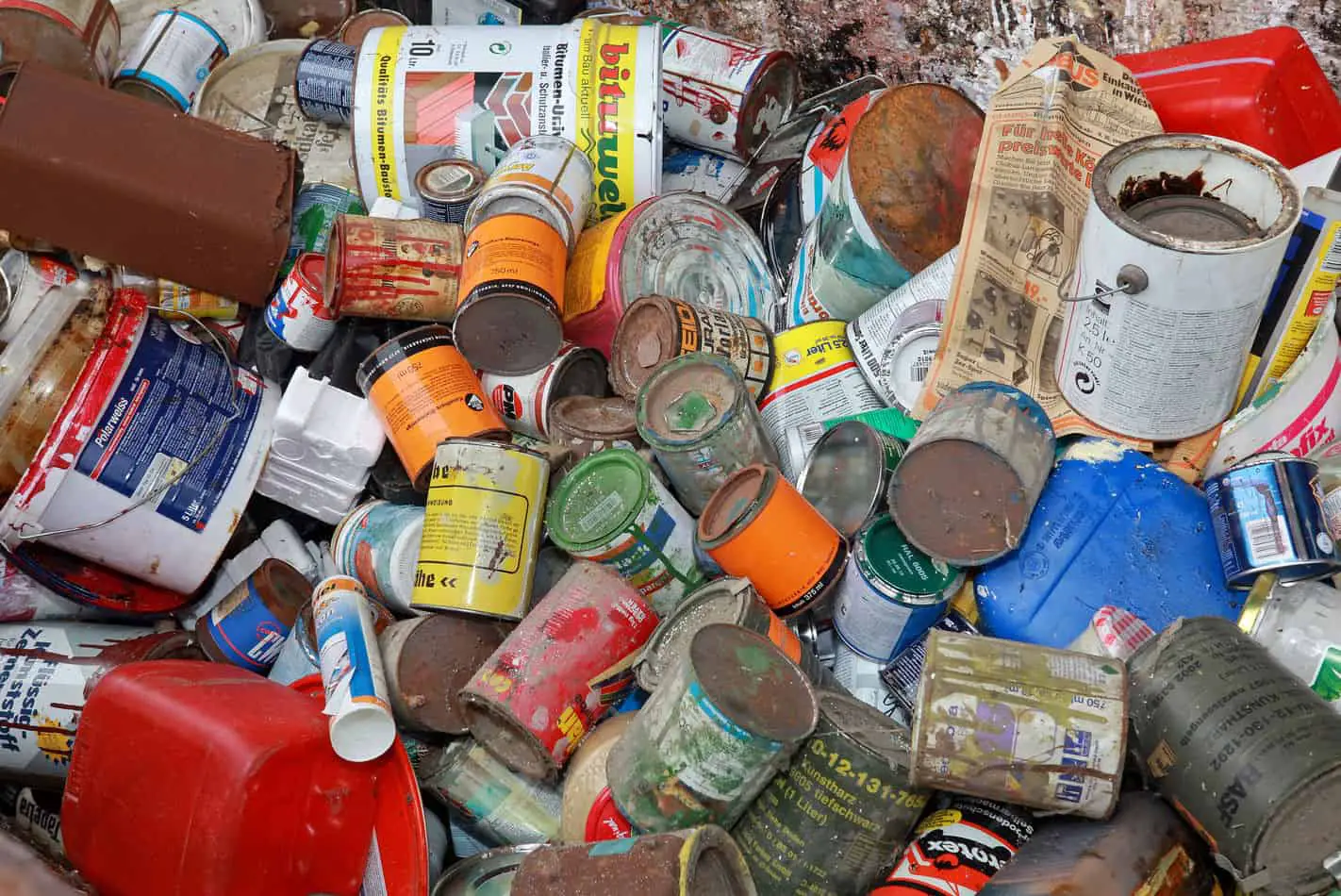After all the fun and hard work you put into your painting, now comes the cleaning up part, and you may be wondering, how do I clean up the leftover paint? Well, here is a quick guide to show you how to dispose of your acrylic paint easily and environmentally safe.
There are a few ways to dispose acrylic paint. If you have a large amount of cans or tubs that you know you won’t be using anymore, you can start by donating them to many charities or groups in your area. A simpler way of disposing your acrylic paint is to simply let is dry and throw it out.
If you decide to dispose of paint in the trash, it must be dried out or hardened. What I usually do is rinse my brushes out and if it’s close to nothing left on the palette, I will rinse it out in the sink as well, but usually I will let it dry before throwing anything away. I reuse a palette with dried up paint until there’s no more room, and then I will replace my palette. It all depends on how much paint you need to dispose of really.
If it’s just tubes and small cans, then I suggest letting it dry out. If you have tons and tons of cans, then a paint hardener might be a better option.

To dry out a can of water-based paint that’s less than a quarter full, simply remove the lid and leave it in a well-ventilated place for a few days. Speed drying of fuller paint containers by adding mulch, kitty litter, shredded paper or a commercial paint hardener. I have used this Homax Paint Hardener in the past, and it worked quite well.
Can You Pour Acrylic Paint Down the Drain?
Acrylics are a more environmentally friendly alternative to oil paint because they are water based. However, you should not pour this rinse water down drains because many of the paints still have toxic chemicals.
Even non-toxic” paints, the pigments and acrylic polymers are difficult for water treatment plants to handle, so it’s best to avoid putting acrylics down the drain.
Overall, it is better to dispose of acrylic paint in solid, rather than liquid, form. Here are some tips for getting rid of your acrylic paints:
• Use only what you need, and store leftovers in airtight containers. If you know you won’t be painting again for a long time, let the excess dry before disposing of it in your solid waste rather than pouring it down the drain.
• Wipe your paint off your brushes before rinsing by squeezing out as much paint as you can into an old rag or newspaper (allow these to dry before tossing out). This will keep your rinsing water cleaner for longer periods.
• Alternatively, keep an unwanted canvas aside specifically for wiping off that extra paint. You’ll have a painting that evolves along with you.
• Keep a large open container, like a 5 gallon bucket, where you can dump your dirty water. Cover with a wire cover to keep out kids and pets, and leave the bucket out to evaporate, after which you can peel out the dried paint.
• If you have room, keep a series of buckets going. Let the fullest one settle, then decant the clearer water off the top. Let the remainder evaporate, while using another bucket for your more recent dirty water.
• If you can’t let your water dry, at least strain out what you can before disposing of the water. Pour the dirty water into a bucket lined with pantyhose. Holes in the bucket will let the filtered water through; alternatively, fill the bucket with the dirty water and then pull out the pantyhose.
• Be extra careful when handling and disposing of toxic pigments. Never pour these down the drain. (This applies to oil paints too.)
Is Acrylic Paint Recyclable?
Yes, you can recycle all paint, especially water based paint like acrylics. Acrylic paint is the most commonly donated or recycled type of paint.

First, make sure you store your water-based paint in a cool, dry place away from flammable materials. Avoiding a fire hazard is your number one priority. If you open a can, make sure to cover it up with an air-tight seal. You can usually reattach the paint can lid.
You can also donate your used paint cans to other organizations (e.g. schools) that will use them.
Oil-based paint can’t be recycled at all, so you’ll need to dispose of them at the proper facility. Interesting enough, you can dry out the paint with used kitty litter or newspaper to avoid flammability.
Recycling water-based paint might be an option in your city. Some cities offer special programs or events for disposing of the latex / water-based paint.
Over the years I have disposed of tons of acrylic paints. For the ones I didn’t dispose of, I recycled and donated in my city. There are always programs that are accepting donations near you, so make sure to check that out before you dispose of them in the trash.
Paint Items You Might Need to Dispose of
There are several kinds of materials you might need to dispose of when using acrylic paints. These can include:
- Solvents found in paint or paint thinners
- Left over water from acrylic and water-based paints
- Paints that contain oils or heavy metals
- Rags that have come in contact with any of the materials above (e.g. paints, solvent, water spill off, etc.)
- Any item with the Prop 65 label from California
- Aerosol cans

